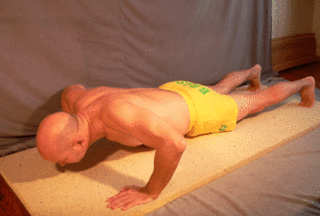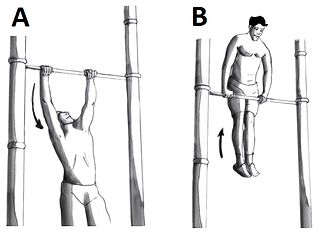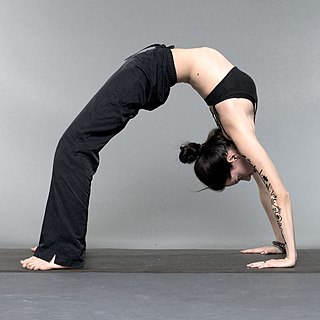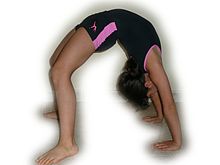
Calisthenics or callisthenics (/ˌkælɪsˈθɛnɪk/) is a form of strength training that utilizes an individual's body weight as resistance to perform multi-joint, compound movements with little or no equipment.
Professional wrestling holds include a number of set moves and pins used by performers to immobilize their opponents or lead to a submission. This article covers the various pins, stretches and transition holds used in the ring. Some wrestlers use these holds as their finishing maneuvers, often nicknaming them to reflect their character or persona. Moves are listed under general categories whenever possible.

The clean and jerk is a composite of two weightlifting movements, most often performed with a barbell: the clean and the jerk. During the clean, the lifter moves the barbell from the floor to a racked position across the deltoids, without resting fully on the clavicles. During the jerk, the lifter raises the barbell to a stationary position above the head, finishing with straight arms and legs, and the feet in the same plane as the torso and barbell.
A suplex is an offensive move used in sport wrestling as well as amateur wrestling and professional wrestling. It is a throw that involves lifting the opponents and bridging or rolling to slam them on their backs.

The bench press, or chest press, is a weight training exercise where a person presses a weight upwards while lying horizontally on a weight training bench. The bench press is a compound movement, with the primary muscles involved being the pectoralis major, the anterior deltoids, and the triceps brachii. Other muscles located in the back, legs and core are involved for stabilization. A barbell is generally used to hold the weight, but a pair of dumbbells can also be used.

The push-up is a common calisthenics exercise beginning from the prone position. By raising and lowering the body using the arms, push-ups exercise the pectoral muscles, triceps, and anterior deltoids, with ancillary benefits to the rest of the deltoids, serratus anterior, coracobrachialis and the midsection as a whole. Push-ups are a basic exercise used in civilian athletic training or physical education and commonly in military physical training. They are also a common form of punishment used in the military, school sport, and some martial arts disciplines. Variations of push-ups, such as wide-arm push-ups, diamond push-ups target specific muscle groups and provide further challenges.

A squat is a strength exercise in which the trainee lowers their hips from a standing position and then stands back up. During the descent, the hip and knee joints flex while the ankle joint dorsiflexes; conversely the hip and knee joints extend and the ankle joint plantarflexes when standing up. Squats also help the hip muscles.

The deadlift is a weight training exercise in which a loaded barbell or bar is lifted off the ground to the level of the hips, torso perpendicular to the floor, before being placed back on the ground. It is one of the three powerlifting exercises, along with the squat and bench press, as well as a frequent lift in strongman. It is also occasionally used in armlifting.

The lying triceps extension, also known as skull crusher and French extension or French press, is a strength exercise used in many different forms of strength training. It is one of the most stimulating exercises to the entire triceps muscle group in the upper arm, and works the triceps from the elbow all the way to the latissimus dorsi. Due to its full use of the triceps muscle group, the lying triceps extensions are used by many as part of their training regimen.

A handspring is an acrobatic move in which a person executes a complete revolution of the body by lunging headfirst from an upright position into an inverted vertical position and then pushing off from the floor with the hands so as to leap back to an upright position. The direction of body rotation in a handspring may be either forward or backward, and either kind may be performed from a stationary standing position or while in motion.

In weight training, a kettlebell is a cast-iron or cast-steel ball with a handle attached to the top. It is used to perform many types of exercises, including ballistic exercises that combine cardiovascular, strength and flexibility training. Kettlebells are the primary equipment used in the weight-lifting sport of kettlebell lifting.
The good-morning is a weight training exercise. It is known as a good morning because of the movement in the erector spinae which resembles the bow that traditionally begins a schoolday in some East-Asian countries. The erector spinae muscles of the lower back work isometrically to keep the spine in an extended position while the hamstrings and gluteus maximus work isotonically to perform hip extension. Other muscles are involved in stabilizing weight on the back and maintaining balance.

The muscle-up is an advanced strength training exercise, within the domain of calisthenics. It is a combination routine of a radial pull-up followed by a dip. Variations exist for the rings as well as the bar.

Chakrasana or Urdhva Dhanurasana is a backbending asana in yoga as exercise. The one-legged variant is often chosen by yoga practitioners who wish to advertise themselves.

A fly or flye is a strength training exercise in which the hand and arm move through an arc while the elbow is kept at a constant angle. Flies are used to work the muscles of the upper body. Because these exercises use the arms as levers at their longest possible length, the amount of weight that can be moved is significantly less than equivalent press exercises for the same muscles . Due to this leverage, fly exercises of all types have a large potential to damage the shoulder joint and its associated ligaments and the tendons of the muscles connecting to it. They should be done with caution and their effects first tested while using very light weights; which are gradually incremented after more strength is gained.

The Roman chair is a piece of exercise equipment. It is mainly used for the lower back, but can also target the buttocks, hamstrings, and abdomen. The definition of the equipment, and what 'Roman chair exercise' specifically means, is not clear.
Calf raises are a method of exercising the triceps surae, tibialis posterior, and peroneal muscles of the lower leg. The movement performed is plantar flexion, also called ankle extension.

The leg raise is a strength training exercise which targets the iliopsoas. Because the abdominal muscles are used isometrically to stabilize the body during the motion, leg raises are also often used to strengthen the rectus abdominis muscle and the internal and external oblique muscles.

Power training typically involves exercises which apply the maximum amount of force as fast as possible; on the basis that strength + speed = power. Jumping with weights or throwing weights are two examples of power training exercises. Regular weight training exercises such as the clean and jerk and power clean may also be considered as being power training exercises due to the explosive speed required to complete the lifts. Power training may also involve contrasting exercises such as heavy lifts and plyometrics, known as complex training, in an attempt to combine the maximal lifting exertions with dynamic movements. This combination of a high strength exercise with a high speed exercise may lead to an increased ability to apply power. Power training frequently specifically utilises two physiological processes which increase in conjunction with one another during exercise. These are deep breathing, which results in increased intra-abdominal pressure; and post-activation potentation, which is the enhanced activation of the nervous system and increased muscle fibre recruitment. Power training programmes may be shaped to increase the trainee's ability to apply power in general, to meet sports specific criteria, or both.
















